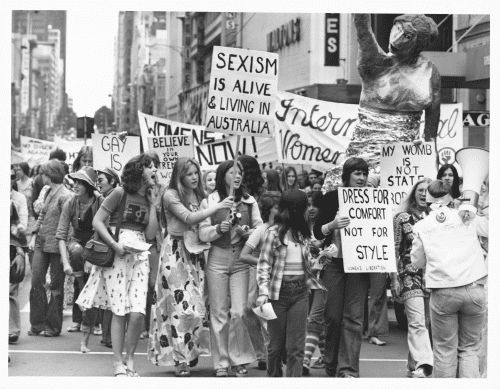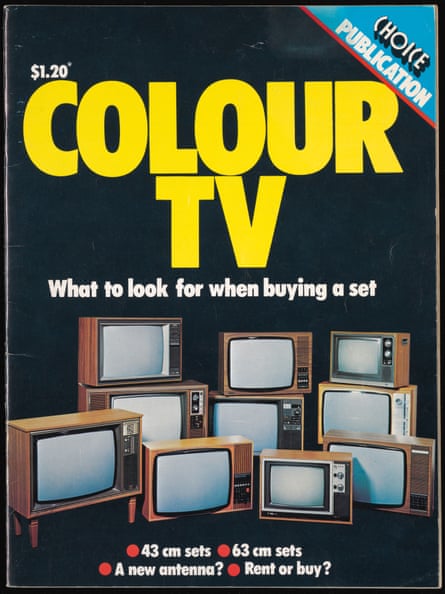Seismic political shake-ups, international upheaval that reverberated across the nation and a vivid cultural renaissance 1975 was one of Australias most pivotal years of the 20th century.
Five decades on, the National Library of Australia in Canberra is about to unveil a new exhibition spotlighting the year the prime minister was sacked, the Vietnam war came to an end and how, despite Hollywood telling us wed never go back into the water, we did.
Taking the title of the seminal Skyhooks album as inspiration, 1975: Living in the Seventies will explore how global conflict, pop culture, fashion and political reforms collided during a time of deep transformation.
 Women on the march wave their placards at the International Womens Day march, Melbourne, 1975. Photograph: John McKinnon / Australian Information Service
Women on the march wave their placards at the International Womens Day march, Melbourne, 1975. Photograph: John McKinnon / Australian Information Service It is what the librarys director of exhibitions, Guy Hansen, calls one of Australias hinge years, up there with 1914 and 1949, when Australians ceased to be British subjects and a federal election ushered in the Menzies era respectively.
Australia started to go in a distinct direction, says Hansen, who was a primary school student in Sydneys western suburbs at the time.
And of course, back then everybody watched the same news. The family would sit down and watch the seven oclock news and hear what James Dibble had to say about things & and even if you were 11, you got a sense of the world.
 Gough Whitlam speaking on the steps of Parliament House, Canberra. Photograph: Australian Information Service
Gough Whitlam speaking on the steps of Parliament House, Canberra. Photograph: Australian Information Service The year did not begin well. The cleanup from Cyclone Tracys devastation had just begun the death toll had risen to 66 and five days into the new year 12 lives were lost when the bulk ore carrier MV Lake Illawarra struck the Tasman Bridge in Hobart.
And it was bookended by the dismissal of Gough Whitlams government on 11 November, sparking one of the most intense collective public reactions in Australian political history.
Under Whitlam the nation underwent sweeping changes to healthcare, divorce law and immigration policy, pushing Australia toward multiculturalism. And global events had not had such an enormous local impact since the outbreak of the second world war.
 A pamphlet from the Australian Consumers Association about the shocking new technology of colour TV. Photograph: Australian Consumers Association
A pamphlet from the Australian Consumers Association about the shocking new technology of colour TV. Photograph: Australian Consumers Association The civil war that began in Lebanon would lead to 30,000 people migrating to Australia. Three times that number arrived from Vietnam after the fall of Saigon.
One neighbour to the north, Papua New Guinea, gained independence from Australia; another, Indonesia, invaded East Timor, with the diplomatic crisis deepening after news of the murder of five Australian journalists in Balibo.
Australia was unable to quarantine itself from global economic stagflation and a looming energy crisis and watched on in wonder as Margaret Thatcher became the first woman in British history to take over the leadership of a major political party.
The countrys hallowed communications institutions were disbanded, with the Postmaster-Generals Department becoming Telecom Australia and the Australian Postal Commission becoming Australia Post. The safari-suit wearing South Australian premier, Don Dunstan, scandalised conservative Australia with his decision to decriminalise homosexual acts between consenting adults.
skip past newsletter promotionSign up to Saved for Later
Catch up on the fun stuff with Guardian Australia's culture and lifestyle rundown of pop culture, trends and tips
Privacy Notice: Newsletters may contain info about charities, online ads, and content funded by outside parties. For more information see our Privacy Policy. We use Google reCaptcha to protect our website and the Google Privacy Policy and Terms of Service apply.after newsletter promotion
As gay rights were ushered in, the symbolic start of Indigenous land rights was marked by Whitlam pouring soil into the hands of the Gurindji leader Vincent Lingiari.
 Carole Johnson leads a class in modern dance at the Black Theatre arts & cultural centre, Sydney, 1975. Photograph: Bill Payne
Carole Johnson leads a class in modern dance at the Black Theatre arts & cultural centre, Sydney, 1975. Photograph: Bill Payne It was also a year of youth-led culture. Double J became the new young voice of Australian music, Molly Meldrum the face of the countrys most popular music show and Skyhooks dominated the year as Australias answer to the big glam rock bands emerging out of London.
Australia switched to colour television.
And while everyone under the age of 30 was busy doing the Time Warp and swearing to never set foot in the water again, Australian films also came into their own.
Youve got movies like Picnic at Hanging Rock [and] Sunday Too Far Away, popular, important movies made by Australian directors with Australian actors, Hansen says.
Theres this kind of strong nationalism and cultural pride in the 70s, with this desire to tell Australian stories.
 Ian Molly Meldrum, Prahran, 1978. Photograph: Rennie Ellis
Ian Molly Meldrum, Prahran, 1978. Photograph: Rennie Ellis The exhibition promises to be more than just a heavy dose of baby boomer nostalgia, he says. It demonstrates how 1975 redefined what it meant to be Australian.
1975: Living in the Seventies opens at the National Library of Australia on 14 August and continues until 1 February. Entry is free.



